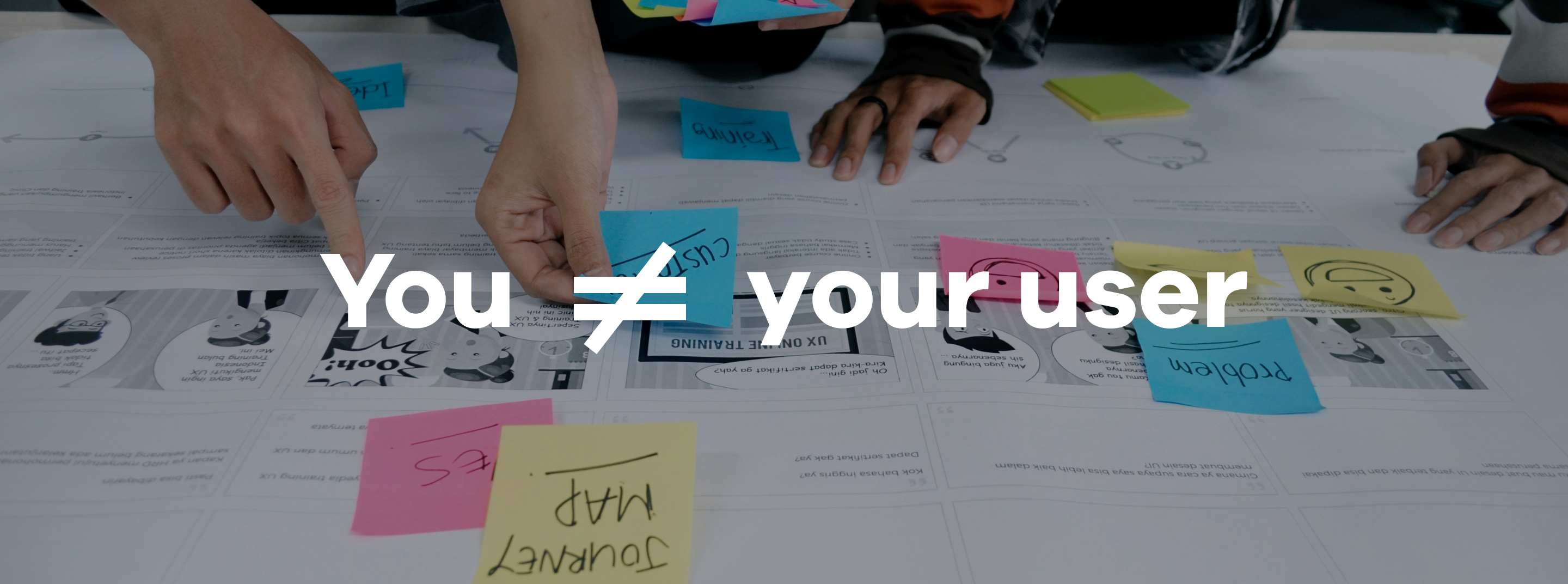
You are not your user
”You are not your user" (1) has become one of the most common mantras in user experience, and rightly so. I can sense you thinking, "Tell me something new." Well, despite being constantly reminded of this, designers (myself included, most certainly) tend to revert to treating ourselves as the user.
Just a few days ago, I conducted a quick user test with 6 individuals. I was working on a bundle functionality for a company and shared several versions with them. For the final version, I mentioned, "Don't focus too much on this one; I've already ruled it out, but I'll send it anyway because maybe we can make use of it somehow." As you might anticipate, 6 out of 6 preferred the last version without the slightest doubt. Thanks to this experience, I not only received another reminder to involve users in the process, but it's also the reason I'm writing this post. Hopefully I will give you the reminder that you need.
Why do we keep forgetting our users?
I have a background in Cognitive Science, with that comes a broad knowledge of the cognitive biases that play with us everyday. Many of them make our lives easier and better, but some I must admit, are causing problems. In this case, the biggest troublemaker is The False-Consensus effect (2). This effect refers to when people think everyone shares their beliefs and will act the same way in a situation as them, believing only those very different from them would choose differently. It seems to be a matter of overestimation, you simply overestimate how many people share your view of things.
So when I thought my last bundle version shouldn’t be part of the vote, I was very sure the participants would share the same view. Because everyone is like me, right?
Another troublemaker in the equation is The Availability Bias (3), which refers to the tendency to generalise based on the examples available. We tend to use one example—I could ask a colleague or a friend, and if he or she shares the same view of things as me, it’s confirmed, it will cut it for representing “everyone”. So, only someone who's stupid or very different from us could actually fail to figure it out. Wrong. We are so wrong in believing that. What has happened is rather that you’ve made an overgeneralization based on one person's opinion.
These two cognitive biases play an important role in trying to explain why we keep forgetting our users in the design process. Simply put, we think we are our users.
Tips on how to avoid this rabbit hole
1. Try to identify your assumptions
We make assumptions about all kinds of things every day. I keep falling back to believing that others are like me. It’s deeply woven into our nature to believe so. A great procedure to follow throughout the design process is to try to identify the assumptions that you and your team are making about your intended users. Looking at your design from another perspective will make you see new things, and when you've identified your assumptions, you can tackle it from another angle by testing.
2. Test with users within the target group, not your colleagues
Of course, testing with colleagues or friends is more convenient for you, but it will not result in a design made for your users. As soon as you have a clear understanding of who your users are, they are the ones that should be participating in any user tests. We all have different mental models, and most probably, you and your colleagues have previous knowledge about a certain function, its feasibility, and the company that real users don’t have. This is yet another reason why you or your colleagues aren’t a good sample to test on.
3. Dare to kill your darlings
Have you ever felt that you've designed something you truly believe in—so much so that you don't even want to test it on anyone, risking the need for changes? I think we’ve all been there. We need to get better at killing our darlings; every feedback point you receive from real users will take your design a step closer to an intuitive design and one step closer to a design made for the intended user. Dare to trust the process and where it will take you.
It’s like that special sauce, that secret ingredient, yet not secret - huh?
At the end of the day, we’re only humans, but just by becoming aware of the cognitive biases that keep messing with us, you’re becoming a better designer.
This blog post may not have wowed you with new groundbreaking principles, concepts, and/or techniques, but it has provided you with the most used yet most needed reminder: you are not your user. It’s like that special sauce with that secret ingredient that you want to add to everything. The only difference is that this isn’t a secret recipe; I’m telling you now, you are not your user. That’s the full recipe—go home and use it. Everything will taste so much better.
References:
- NNGroup: https://www.youtube.com/watch?v=-pTc6W1kJOU
- L. Ross, D. Greene, P. House. 1977. The “False Consensus Effect”: An Egocentric Bias in Social Perception and Attribution Processes. Journal Of Experimental Social Psychology.
- Tversky, A., & Kahneman, D. (1973). Availability: A heuristic for judging frequency and probability. Cognitive Psychology, 5(2), 207-232.



Leave a comment
This site is protected by hCaptcha and the hCaptcha Privacy Policy and Terms of Service apply.